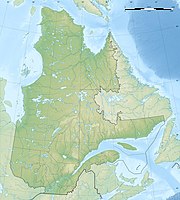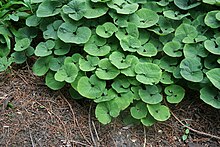Réserve écologique de Pointe-Plato
|
Réserve écologique de Pointe-Plato
|
||
|
The bank of St. Lawrence |
||
| location | Lotbinière , Quebec, Canada | |
| surface | 0.59 km² | |
| WDPA ID | 66634 | |
| Geographical location | 46 ° 40 ′ N , 71 ° 51 ′ W | |
|
|
||
| Setup date | 1995 | |
| administration | MDDEP | |
The Réserve écologique de Pointe-Platon is a protected area established in 1995 on an area of 59.38 hectares in the south of the Canadian province of Québec .
It is located in the regional county town of Lotbinière on the south bank of the Saint Lawrence River in the commune of Sainte-Croix . It protects a representative region of the river area that is accessible for the tides.
The area forms two levels, which are relatively sharply separated from each other by a steep coast. The lower level is the tidal zone. At the end of the last ice age about 12,000 years ago, the glaciers left Tillit mainly on the upper terrace, while the lower one is more characterized by river deposits. Since the area rose in the period afterwards, tree species such as the red ash (Fraxinus pennsylvanica), the net willow ( Salix reticulata ) and alder found favorable locations. The Canadian black poplar ( Populus deltoides ), called here peuple deltoïde , prefers sandy locations, the water of which drains off faster.
The sugar maple prefers the cliffs that separate the two terraces, including Asarum canadens or Canadian hazel root from the genus of hazel root . The sugar maple prefers brown earth that does not dry out too much. The poplar species Populus grandidentata , here called Peuplier à grandes dents , now forms a young forest above the protected area. The areas near the river are more dominated by Spartina pectinata from the genus of silt grass .
43 plant species have so far been identified in the tidal zone alone. Four of the eight endangered plant species in the protected area are threatened. These are the Isoëtes tuckermanii from the genus of the bream herbs ( Isoëtes ), the Lindernia dubia var. Inundata Pennell , which in Québec is called alleviating litigieuse variété estuarienne , the Zizanie à fleurs blanches var. Naine, a water rice species and the Cicuta maculata var. De Victorin from the genus of the water hemlocks . The latter is endemic, so it only occurs here. The Erigeron philadelphicus L. , here called Vergerette de Philadelphie , is extremely rare in Québec . It belongs to the genus of professional herbs .
The fauna has so far been little explored. Many migratory birds visit the marshy Marais in spring and autumn. The great blue heron and numerous sea birds are often found . Even the white-tailed deer and elk can be found here. Nine amphibian species, including six salamander species, have been identified so far. Among these, the black-bellied brook salamander Desmognathus fuscus , which is called here Salamandre sombre du Nord , is endangered .
Web links
- Réserve écologique de Pointe-Platon , government website
Remarks
- ↑ Lindernia dubia var. Inundata Pennell , Database of Vascular Plants of Canada (VASCAN).



